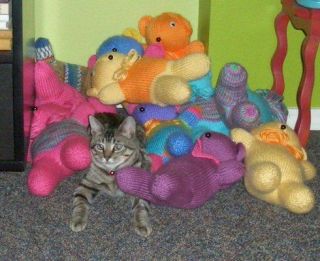In his 2009 book Forensic and Medico-legal Aspects of Sexual Crimes and Unusual Sexual Practices, Dr. Anil Aggrawal defines plushophilia as a “sexual attraction to stuffed toys or people in animal costume, such as theme park characters.” However, other online sources simply define plushophilia as a sexual paraphilia involving stuffed animals. Sexual and pornographic activities involving animal anthropomorphism (including plushophilia), is known among the plushophile community as "yiffing."

Plushophiles are often referred to as plushies, although as I noted in a previous article on the Furry Fandom, the term can also refer to stuffed animal enthusiasts who have no sexual interest at all (i.e., people who just love cuddly toys). Because of an infamous 2001 article by George Gurley in the magazine Vanity Fair, plushophilia is often assumed to be a common practice among members of the Furry Fandom. However, survey research has shown this not to be the case. For instance, an old and unpublished survey from data collected in the late 1990s by David J. Rust of 360 members of the furry community (325 respondents from furry conventions and 25 respondents online) suggested less than 1 percent of them were plushophiles (0.3 percent).
In a more recent (2008) attempt to replicate Rust’s study, Kyle Evans carried out a survey on 276 people who self-identified themselves as being furries and who were recruited from furry or furry-related online message boards and forums. Evans reported a much higher prevalence rate of plushophilia (7 percent) than the study by Rust (although this was still a low prevalence rate suggesting that the overlap between plushophilia and the Furry Fandom is minimal). Evans claimed that because the majority of Rust’s survey was conducted in person at conventions, participants were susceptible to the social desirability bias when it came to plushophilia. Many plushies do not want any association with furries whatsoever.
Many plushophiles are avid collectors of cuddly toys and many began accumulating their collections in childhood (although some have already reached adulthood before their interest in stuffed toys begins). Some plushies are said to be totally obsessed with their hobby and may share behavioural similarities with pathological hoarders. Among a small minority of plushies, the collecting may border on being an obsessive-compulsive disorder. Like many collectors, plushies may focus their collecting behaviour on very specific types of cuddly toy such as teddy bears. For some plushies, their passion for collecting may lead them to careers that involve making and/or trading plush toy animals. The online Wiki Fur website claims that:
 “A common practice among plushophiles who are serious collectors is to purchase two of each plushie; one for display and use, and another for safe keeping and preservation. Many plushophiles consider their toys very dear and rarely trade or sell them, even when there are concerns such as limited space and storage”.
“A common practice among plushophiles who are serious collectors is to purchase two of each plushie; one for display and use, and another for safe keeping and preservation. Many plushophiles consider their toys very dear and rarely trade or sell them, even when there are concerns such as limited space and storage”.
As mentioned earlier, a small number of furries consider themselves plushophiles. Some furries and/or plushies have specific animistic beliefs (i.e., a set of beliefs concerning the existence of non-human "spiritual beings") that cross over into their love of toy animals. Furthermore, for some furries, toy animals are said to serve as representations of totem animals. The Wiki Fur website defines an animal totem as:
“An important symbolic object in furry spirituality used by a person to get in touch with specific qualities found within an animal which the person needs, connects with, or feels a deep affinity toward. Some Furry lifestylers find they draw spiritual energy from a totem animal which guides their lives and causes them to imitate behaviors of that animal”.


The sexual element of plushophilia has been overplayed and sensationalized by both the print and broadcast media. However, there are plushie sex and dating sites (such as http://plushielove.freeforums.org/ and http://plush.yiff.ru/), and for those plushies where sex is an important part of their activity, their behaviour has been argued by the Wiki Fur website to be a genuine sexual paraphilia.
“Depending on the individual, sexual stimulation and plush toys may arise from purely sensual enjoyment, may act as an aid for fantasy gratification and physical or mental stimulation alone or with another person, or may have an animistic and spiritual component. For example, some plushophiles who make use of their toys in intimate ways do so with a partner, while others only experience such feelings toward a plush animal that they view as more than an inanimate object. A common practice among sexual plushophiles is to modify a plush toy in order to make it sexually accessible or to minimize damage to it from such use.”
However, Wiki Fur is quick to point out that not all plushies who relate to their toys sexually modify them, and not plushies actually make direct contact with their stuffed toys for intimate stimulation. One infamous plushophile is FoxWolfie Galen who has his own website was interviewed for Salon magazine. He was first asked how he had sex with a stuffed animal:
“Well, none of [my toy animals] have an SPA [strategically placed appendage]. It’s been thought of a couple of times, but part of the difficulty would be constructing one and not having it fall off the plushie. That’s a problem people have dwelled on for a long time. It’s usually just cuddling and rubbing with me. There’s usually no need for the penetration. Most of [my toy animals] don’t have an SPH [strategically placed hole], but some do. It’s not a requirement for me – if’s there I’ll use it, and if not, I’m just as happy without it. It all depends on what you allow happen to them. Some people wear condoms for complete protection”.

Galen has more than a 1000 stuffed animals and he was asked how he chooses his “sexual partners.” He said: “It’s basically the same as with people,” Galen says in explaining how he chooses his lucky winners. Some you’re attracted to sexually and some you’re not. I’m not interested in just human-human [sex]; it’s gotta be human-plushie-human. The person would have to be interested in plush.”
Academic research is beginning to be carried out on plushophilia (but only in relation to Furry Fandom and/or zoophilia). There are some aspects of plushophilia that might have psychological resonance with pathological collecting and hoarding, but most research is likely to examine the more sexual elements of plushophiles’ lifestyle.
References and further reading
Aggrawal A. (2009). Forensic and Medico-legal Aspects of Sexual Crimes and Unusual Sexual Practices. Boca Raton: CRC Press.
Evans, K. (2008). The furry sociological survey. Located at: http://www.cannedgeek.com/images/sharedfiles/fss_report_finaldraft.PDF
FoxWolfie Galen’s Plushie Page (2012). Definitions. Located at: http://www.velocity.net/~galen/furrydef.html
Gerbasi, K. C., Paolone, N., Higner, J., Scaletta, L. L., Bernstein, P. L., Conway, S., & Privitera, A. (2008). Furries from A to Z (anthropomorphism to zoomorphism). Society & Animals, 16(3), 197-222.
Hill, D. (2000). Cuddle time: In the world of plushophiles, not all stuffed animals are created equal. Salon, June 19. Located at: http://www.salon.com/2000/06/19/plushies/
Rust, D.J. (2001). The sociology of furry fandom. Located at: http://www.visi.com/~phantos/furrysoc.html
Wiki Fur (2012). Animal totem. Located at: http://en.wikifur.com/wiki/Animal_totem
Wiki Fur (2012). Plushophilia. Located at: http://en.wikifur.com/wiki/Plushophilia




